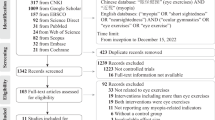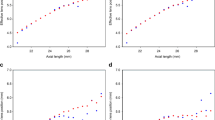Abstract
Background/Objectives
To determine the relationship between corneal stress-strain index (SSI) and retinal nerve fibre layer (RNFL) thickness.
Subjects/Methods
1645 healthy university students from a university-based study contributed to the analysis. The RNFL thickness was measured by high-definition optical coherence tomography (HD-OCT), axial length (AL) was measured by IOL Master, and corneal biomechanics including SSI, biomechanical corrected intraocular pressure (bIOP), and central corneal thickness (CCT) were measured by Corvis ST. Multivariate linear regression was performed to evaluate the relationship between the SSI and RNFL thickness after adjusting for potential covariates.
Results
The mean age of the participants was 19.0\(\pm \)0.9 years, and 1132 (68.8%) were women. Lower SSI was significantly associated with thinner RNFL thickness (\(\beta \)=8.601, 95% confidence interval [CI] 2.999–14.203, \(P\) = 0.003) after adjusting for age, CCT, bIOP, and AL. No significant association between SSI and RNFL was found in men, while the association was significant in women in the fully adjusted model. The association was significant in the nonhigh myopic group (\(P\) for trend = 0.021) but not in the highly myopic group. Eyes with greater bIOP and lower SSI had significantly thinner RNFL thickness.
Conclusions
Eyes with lower SSI had thinner RNFL thickness after adjusting for potential covariates, especially those with higher bIOP. Our findings add novel evidence of the relationship between corneal biomechanics and retinal ganglion cell damage.
This is a preview of subscription content, access via your institution
Access options
Subscribe to this journal
Receive 18 print issues and online access
$259.00 per year
only $14.39 per issue
Buy this article
- Purchase on Springer Link
- Instant access to full article PDF
Prices may be subject to local taxes which are calculated during checkout



Similar content being viewed by others
Data availability
The data that support the findings of this study are available upon reasonable request.
References
Weinreb RN, Aung T, Medeiros FA. The pathophysiology and treatment of glaucoma: a review. JAMA. 2014;311:1901–11.
Miki A, Medeiros FA, Weinreb RN, Jain S, He F, Sharpsten L, et al. Rates of retinal nerve fiber layer thinning in glaucoma suspect eyes. Ophthalmology. 2014;121:1350–8.
Lee M-W, Kim J-m, Shin Y-I, Jo Y-J, Kim J-Y. Longitudinal changes in peripapillary retinal nerve fiber layer thickness in high myopia. Ophthalmology. 2019;126:522–8.
Du J, Du Y, Xue Y, Wang H, Li Y. Factors associated with changes in peripapillary retinal nerve fibre layer thickness in healthy myopic eyes. J Ophthalmol. 2021; https://doi.org/10.1155/2021/3462004.
Ruberti JW, Sinha Roy A, Roberts CJ. Corneal biomechanics and biomaterials. Annu Rev Biomed Eng. 2011;13:269–95.
Bao F, Geraghty B, Wang Q, Elsheikh A. Consideration of corneal biomechanics in the diagnosis and management of keratoconus: is it important? Eye Vis (Lond). 2016; https://doi.org/10.1186/s40662-016-0048-4.
Dackowski EK, Lopath PD, Chuck RS. Preoperative, intraoperative, and postoperative assessment of corneal biomechanics in refractive surgery. Curr Opin Ophthalmol. 2020;31:234–40.
Wang W, Du S, Zhang X. Corneal deformation response in patients with primary open-angle glaucoma and in healthy subjects analyzed by Corvis ST. Invest Ophthalmol Vis Sci. 2015;56:5557–65.
Park JH, Jun RM, Choi K-R. Significance of corneal biomechanical properties in patients with progressive normal-tension glaucoma. Br J Ophthalmol. 2015;99:746–51.
Bueno-Gimeno I, Gene-Sampedro A, Piñero-Llorens DP, Lanzagorta-Aresti A, España-Gregori E. Corneal biomechanics, retinal nerve fiber layer, and optic disc in children. Optom Vis Sci. 2014;91:1474–82.
Khawaja AP, Chan MP, Broadway DC, Garway-Heath DF, Luben R, Yip JL, et al. Corneal biomechanical properties and glaucoma-related quantitative traits in the EPIC-Norfolk Eye Study. Invest Ophthalmol Vis Sci. 2014;55:117–24.
Zhang C, Tatham AJ, Abe RY, Diniz-Filho A, Zangwill LM, Weinreb RN, et al. Corneal hysteresis and progressive retinal nerve fiber layer loss in glaucoma. Am J Ophthalmol. 2016;166:29–36.
Qassim A, Mullany S, Abedi F, Marshall H, Hassall MM, Kolovos A, et al. Corneal stiffness parameters are predictive of structural and functional progression in glaucoma suspect eyes. Ophthalmology. 2021;128:993–1004.
Lim L, Gazzard G, Chan YH, Fong A, Kotecha A, Sim EL, et al. Corneal biomechanics, thickness and optic disc morphology in children with optic disc tilt. Br J Ophthalmol. 2008;92:1461–6.
Mansouri K, Leite MT, Weinreb RN, Tafreshi A, Zangwill LM, Medeiros FA. Association between corneal biomechanical properties and glaucoma severity. Am J Ophthalmol. 2012;153:419–27.e1.
Chang PY, Chang SW. Corneal biomechanics, optic disc morphology, and macular ganglion cell complex in myopia. J Glaucoma. 2013;22:358–62.
Xu Y, Ye Y, Chen Z, Xu J, Yang Y, Fan Y, et al. Corneal stiffness and modulus of normal-tension glaucoma in Chinese. Am J Ophthalmol. 2022;242:131–8.
Eliasy A, Chen KJ, Vinciguerra R, Lopes BT, Abass A, Vinciguerra P, et al. Determination of corneal biomechanical behavior in-vivo for healthy eyes using CorVis ST tonometry: stress-strain index. Front Bioeng Biotechnol. 2019; https://doi.org/10.3389/fbioe.2019.00105.
Dong XX, Liang G, Li DL, Liu MX, Yin ZJ, Li YZ, et al. Association between parental control and depressive symptoms among college freshmen in China: The chain mediating role of chronotype and sleep quality. J Affect Disord. 2022;317:256–64.
Liu MX, Li DL, Yin ZJ, Li YZ, Zheng YJ, Qin Y, et al. Smoking, alcohol consumption and corneal biomechanical parameters among Chinese university students. Eye (Lond). 2023;37:2723–9.
Lee H, Roberts CJ, Kim TI, Ambrósio R Jr., Elsheikh A, Yong Kang DS. Changes in biomechanically corrected intraocular pressure and dynamic corneal response parameters before and after transepithelial photorefractive keratectomy and femtosecond laser-assisted laser in situ keratomileusis. J Cataract Refractive Surg. 2017;43:1495–503.
Roberts CJ. Concepts and misconceptions in corneal biomechanics. J Cataract Refractive Surg. 2014;40:862–9.
Edmund C. Corneal elasticity and ocular rigidity in normal and keratoconic eyes. Acta Ophthalmol. 1988;66:134–40.
Safa BN, Wong CA, Ha J, Ethier CR. Glaucoma and biomechanics. Curr Opin Ophthalmol. 2022;33:80–90.
Downs JC, Girkin CA. Lamina cribrosa in glaucoma. Curr Opin Ophthalmol. 2017;28:113–9.
McBrien NA, Gentle A. Role of the sclera in the development and pathological complications of myopia. Prog Retin Eye Res. 2003;22:307–38.
Metzler KM, Mahmoud AM, Liu J, Roberts CJ. Deformation response of paired donor corneas to an air puff: intact whole globe versus mounted corneoscleral rim. J cataract Refractive Surg. 2014;40:888–96.
Nguyen BA, Reilly MA, Roberts CJ. Biomechanical contribution of the sclera to dynamic corneal response in air-puff induced deformation in human donor eyes. Exp Eye Res. 2020; https://doi.org/10.1016/j.exer.2019.107904.
Bochmann F, Ang GS, Azuara-Blanco A. Lower corneal hysteresis in glaucoma patients with acquired pit of the optic nerve (APON). Graefe’s Arch Clin Exp Ophthalmol = Albrecht von Graefes Arch fur klinische und experimentelle Ophthalmologie. 2008;246:735–8.
Wong BJ, Moghimi S, Zangwill LM, Christopher M, Belghith A, Ekici E, et al. Relationship of corneal hysteresis and anterior lamina cribrosa displacement in glaucoma. Am J Ophthalmol. 2020;212:134–43.
Wu W, Dou R, Wang Y. Comparison of corneal biomechanics between low and high myopic eyes-a meta-analysis. Am J Ophthalmol. 2019;207:419–25.
Sedaghat MR, Momeni-Moghaddam H, Azimi A, Fakhimi Z, Ziaei M, Danesh Z, et al. Corneal biomechanical properties in varying severities of Myopia. Front Bioeng Biotechnol. 2020; https://doi.org/10.3389/fbioe.2020.595330.
Jonas JB, Ohno-Matsui K, Panda-Jonas S. Myopia: anatomic changes and consequences for its etiology. Asia-Pac J Ophthalmol (Phila, Pa). 2019;8:355–9.
Kang BS, Wang LK, Zheng YP, Guggenheim JA, Stell WK, Kee CS. High myopia induced by form deprivation is associated with altered corneal biomechanical properties in chicks. PLoS One. 2018; https://doi.org/10.1371/journal.pone.0207189.
Liu G, Rong H, Zhang P, Xue Y, Du B, Wang B, et al. The effect of axial length elongation on corneal biomechanical property. Front Bioeng Biotechnol. 2021; https://doi.org/10.3389/fbioe.2021.777239.
Chu Z, Ren Q, Chen M, Cheng L, Cheng H, Cui W, et al. The relationship between axial length/corneal radius of curvature ratio and stress-strain index in myopic eyeballs: Using Corvis ST tonometry. Front Bioeng Biotechnol. 2022; https://doi.org/10.3389/fbioe.2022.939129.
Funding
Funded by National Natural Science Foundation of China (Grant No. 82122059 and No. 82160204) and Nankai University Eye Institute (NKYKD202206).
Author information
Authors and Affiliations
Contributions
Study conception and design: CWP, GL. Data collection: MXL, DLL, ZJY, YZL, YJZ, YQ, RM. Data analysis and interpretation: MXL, DLL, YZL; Paper writing: MXL, CWP. Final approval of paper: all authors.
Corresponding authors
Ethics declarations
Competing interests
The authors declare no competing interests.
Additional information
Publisher’s note Springer Nature remains neutral with regard to jurisdictional claims in published maps and institutional affiliations.
Rights and permissions
Springer Nature or its licensor (e.g. a society or other partner) holds exclusive rights to this article under a publishing agreement with the author(s) or other rightsholder(s); author self-archiving of the accepted manuscript version of this article is solely governed by the terms of such publishing agreement and applicable law.
About this article
Cite this article
Liu, MX., Li, DL., Yin, ZJ. et al. Corneal stress‒strain index in relation to retinal nerve fibre layer thickness among healthy young adults. Eye 38, 1654–1659 (2024). https://doi.org/10.1038/s41433-024-02985-7
Received:
Revised:
Accepted:
Published:
Issue Date:
DOI: https://doi.org/10.1038/s41433-024-02985-7



